Movie Review
 |
 |
 |
 |
 |
 |
 |
A Foolish & Revolutionary Depiction
of St. Francis of Assisi
directed by Franco Zeffirelli, Paramount Pictures, 1972
Christina Herath

Brother Sun, Sister Moon, although claiming to be based loosely on an early hagiography of the Saint, is brimming with inaccuracies that are blatantly blasphemous to the great Founder of the Franciscan Order.
Strange opening scenes
The film opens with a confusing first set of scenes that already offend St. Francis, who is seen sick in bed, tormented by images from his past.
Then we see Francis the knight riding off for adventure in the Crusades. Instead of seeing a chivalric young man filled with idealism, we see a giddy adolescent diverted from his journey to chase after a beautiful young woman. The two young people are Francis and Clare. Francis stares creepily at Clare, who is about to feed some lepers, something disgusting to Francis, who draws away. He wakes up screaming.
It is necessary to comment on the deplorable way the cinema industry in general has treated the relationship of these two great Saints. More than once they have been portrayed as being more than just friends. This is an absurd falsity.
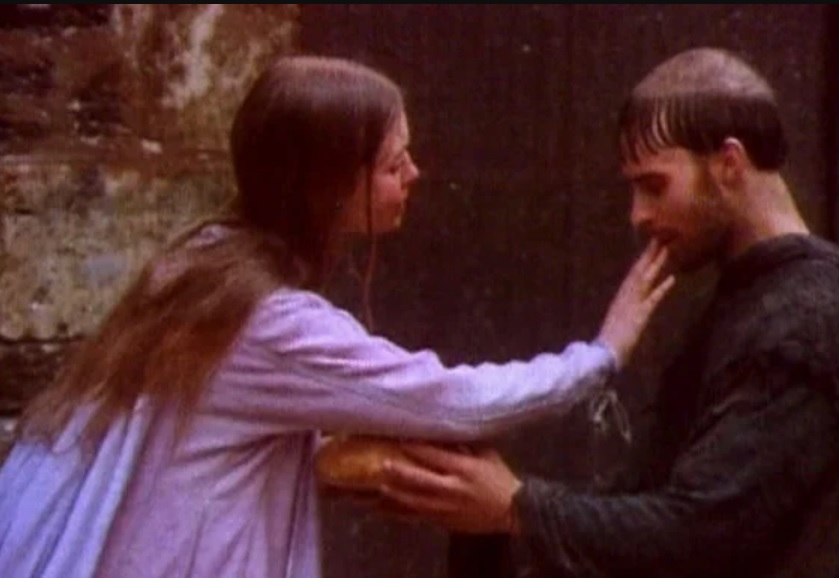
A deplorable intimacy in the relationship between St. Francis & St. Clare that did not exist
In another reminiscence, we see Francis speaking disrespectfully to his father when the latter complains that his wife and Francis always speak French around him – as if he were not a merchant who would know the language well.
But Francis mocks his father: “If you wanted a wife who speaks like you, why didn’t you marry some thick-headed butcher’s daughter?” His mother applauds his bold remark. Clearly, this is not the medieval Francis who always addressed his parents respectfully.
Sentimental depiction of the Saint
Francis hears the chirping of a little bird outside and rises from his sickbed.
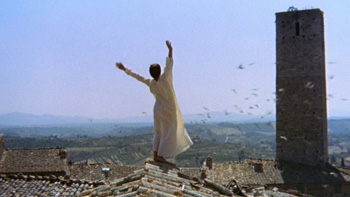
His silly chase after a little bird on the roofs of Assisi
This is not the only time we see a sentimental Francis. No, soon we find him sitting in a field singing about the meadow and flowers, instead of the praises of God as he was wont to do.
A few of many inaccuracies
Since the movie is two hours long and riddled with inaccuracies, I will only mention two here:
- Later, during the Holy Mass, Francis sees the crucified image of Our Lord open His eyes and he yells out “No!”, which makes everyone look at him. The real St. Francis would not have acted so.
- Instead of showing the part of his life where Our Lord tells him, “Francis seest thou not that My house is falling to decay. Go, then, and repair it for Me,” the movie portrays Francis traipsing through the fields where he sees a broken down chapel with a fully intact crucifix. Then, for no apparent reason, he returns home and starts throwing out bolts of expensive cloth to the people on the street from his father’s shop window, crying out “Burn it! All of it!” Another hippie change to the true story.
When his angry father drags him before the Bishop, Francis tells the Prelate that “brother sun,” not God – has illuminated his soul. When asked what he wants, he answers that he wants to be happy and live like the birds in the sky.
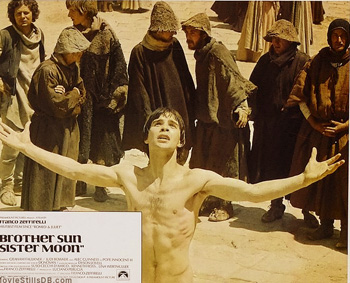
A dramtic stripping to complete nudity
before the Bishop & townspeople
The Bishop covers him with his cloak, but Francis hands it to a poor man and walks away through town fully nude, to the scandal of all. In the true history, Francis only strips his expensive outer garments and gratefully accepts the cloak of a country laborer which the Bishop offers to him. He never appears nude in the streets before men, women and children.
Disdain for order & beauty
In a later scene when his friend Bernardo returns from the Crusades, he is so disillusioned by war that he joins Francis’ effort to rebuild the church with his crew of peasants, who appear dirty and miserabilist.
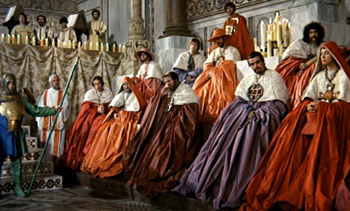
The splendrous court presented as corrupt, cold, worldly
No Saint revolted against the order and hierarchy established by God, not even those who embraced poverty as a vocation. The Saints understood that the hierarchical order was established by God and that power, authority and wealth should be respected. Neither did they rant against beauty, majesty and all that makes the Church and society marvellous.
This movie brings to mind our own times when the Prelates of the Church have stripped the Church of her beauty and made her dwellings poor and ugly boxes, unworthy of the Real Presence.
Clare’s entrance to the Religious Life
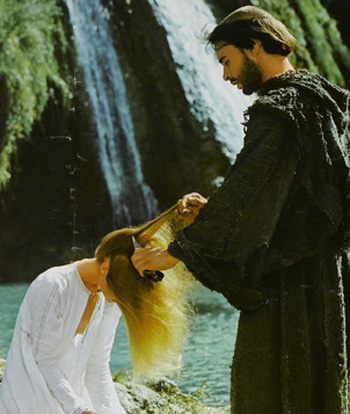
Francis cuts Clare’s hair near a waterfall
in a sentimental scene
These are the words written by Butler of St. Francis and his esteem for the virtue of purity. But the film constantly shows Francis and Clare together in unbecoming intimacy.
Clare’s entrance into the religious life is altered pathetically. We do not see the holy virgin running away from home to the Church of the Portiuncula, where her hair is cut by the holy Founder and she chastely enters religious life before the Altar of Our Lady.
Instead, we see a young woman running through flowery fields, pulling up her dress to show her thighs, looking for Francis; they meet, hold hands and later, by a waterfall she renounces the world, gazing at Francis like a lover.
A different Church
In a symbolic scene the local peasants laden with livestock and flowers come to inaugurate the rebuilt San Damiano Church. The large crowd of people join together in song. Then, suddenly the scene switches to the stately Church of the Bishop, who prays at the altar before a sad congregation of a few rich people.
The message for our times: the Traditional Church, with her hierarchy and order is empty; all the people have gone gleefully to sing and praise the Lord in charismatic man-centered temples. One is reminded of the Jesus Revolution movie. Away with ceremony and decorum; welcome to spontaneous outbursts of joyful praise. Who needs Gregorian chant to praise God when all can sing lines like “Heartfelt joys are holy...”?
Later, the Bishop’s soldiers set fire to the Church of St. Damian. So Francis heads off to Rome to “find out what he’s done wrong.” In fact, Francis went to Rome to obtain the confirmation of his Order and its rule from the Apostolic See.
The ending
The visit to the Pope is another fictional imagining of director Zeffirelli. Kneeling in the Pope’s presence, Francis begins to read his prepared Latin script. Then he drops it, and starts to dramatically quote biblical verses that condemn the immense riches he sees around him; “For where your treasure is, there will your heart be also,” and “No man can serve two masters...” He and his monks are escorted away by guards to prison.
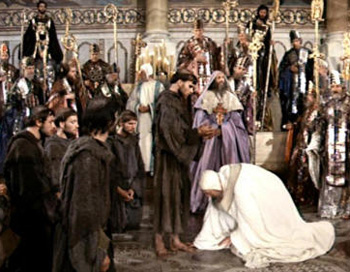
The Pope bends to the feet of Francis to show his approval
But the Pope of the movie calls Francis back to confirm his vocation “to bring man to God through creatures,” adding other questionable statements like “In our obsession with original sin, we too often forget original innocence.” As if original sin did not tarnish our original state of perfection and resulted in our fallen human nature.
The Pope then falls to his knees and kisses Francis’ feet, and the movie ends with a song to “Brother Sun, Sister Moon."
Instead of the marvellous life of the Seraphic Saint who bore the wounds of Christ on his flesh, we are presented with an effeminate miserablist and a fictional rendition of his glorious life. It is better to rely on good books to learn about our Faith and the Saints, not productions like these that surely raise the ire of the Saints and Angels and all true friends of God.
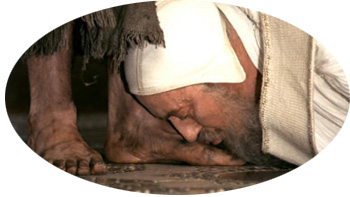
The feet of Francis are dirty & soiled...

Posted November 22, 2023
______________________
______________________





